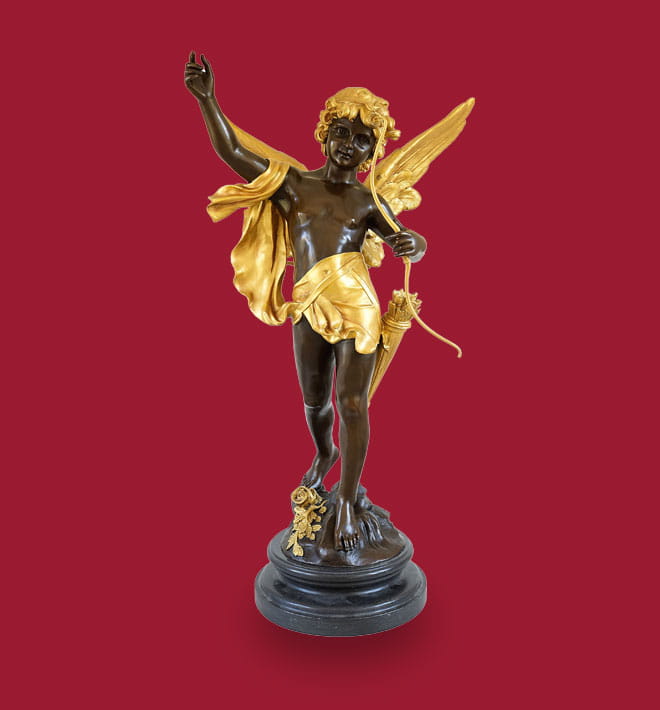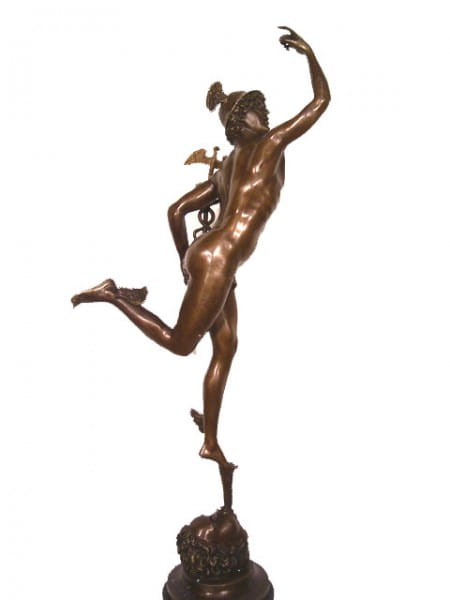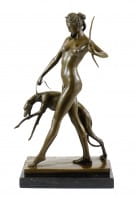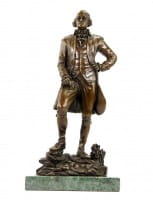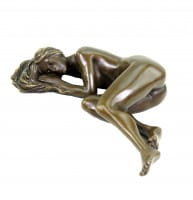€599.00 *
Prices incl. VAT, free shipping worldwide
Ready to ship today,
Delivery time appr. 3-6 workdays










Hermes Bronze Statue on Marble – A Mythological Masterpiece by Giambologna This Hermes... more
Product description
"Hermes Bronze Statue - Giambologna on Marble - Greek Mythology"
| Weight | 6,2 kg |
Hermes Bronze Statue on Marble – A Mythological Masterpiece by Giambologna
This Hermes Bronze Statue on a marble base is a timeless representation of the swift-footed messenger of the gods, Hermes, meticulously crafted in the spirit of Giambologna’s renowned Renaissance sculpture. Capturing Hermes in the midst of flight, the piece celebrates the balance, grace, and agility for which the god is famous. Mounted on a luxurious marble base, the statue embodies both classical elegance and modern craftsmanship, blending ancient Greek mythology with the sophistication of fine art. This bronze sculpture is a striking addition to any collection, reflecting a deep connection to mythology and the artistic mastery of Giambologna.
The Legacy of Giambologna – The Master Behind the Sculpture
Giambologna, born Jean Boulogne (1529–1608), was one of the most influential sculptors of the late Renaissance. A Flemish artist who spent most of his career in Italy, Giambologna is celebrated for his ability to infuse classical forms with a sense of movement and dynamism. His statue of Hermes (also known as Mercury) became one of his signature works, notable for its balance and grace.
In this contemporary bronze interpretation, the spirit of Giambologna’s original design is preserved, with a focus on capturing the fluidity of Hermes’ motion as he takes flight. Giambologna’s mastery of anatomy, proportion, and balance continues to resonate through this sculpture, making it both a historical homage and a modern artistic marvel.
Hermes in Greek Mythology – The Messenger of the Gods
In Greek mythology, Hermes is the swift-footed son of Zeus and Maia, often depicted as the gods’ messenger. Known for his speed and cleverness, Hermes was also the god of trade, travelers, and boundaries. He was believed to guide souls to the underworld, act as a protector of travelers, and facilitate communication between gods and mortals.
Hermes is commonly portrayed with winged sandals and a winged helmet, both of which symbolize his swiftness and ability to move freely between worlds. Additionally, he is often seen holding the caduceus, a staff entwined with two serpents, representing diplomacy and negotiation. This Hermes Bronze Statue captures these defining symbols, presenting the god in a poised and graceful pose that reflects his mythological roles.
Design and Composition – Hermes in Motion
The sculpture presents Hermes in mid-flight, balancing on one foot delicately perched atop a windblown cloud, his body stretched upward as if propelled into the air. His muscular form is finely detailed, with the artist’s focus on anatomical precision and the dynamic lines of the body. His raised arm suggests a gesture of communication, as he holds the caduceus—a symbol of peace and commerce—in his other hand.
The wings on Hermes' sandals and helmet are intricately sculpted, adding to the overall sense of movement and flight. His forward-leaning body, extended limbs, and upward gaze create a visual narrative of swiftness and elegance. This statue embodies Giambologna’s genius in achieving balance and harmony in a single moment of motion, as the entire figure seems to float effortlessly, despite being cast in solid bronze.
Symbolism – Speed, Communication, and Balance
Hermes is a powerful symbol of speed, agility, and the vital importance of communication. In this sculpture, these qualities are embodied in the figure’s pose and attributes. His caduceus represents negotiation and the resolution of conflict, while his winged accessories symbolize his ability to traverse great distances in an instant.
The position of the statue—balanced on one foot with his body in flight—symbolizes both the balance needed in diplomacy and the swift resolution of disputes. The statue’s flowing lines and upward motion further evoke the elegance and lightness that are central to Hermes’ identity as the messenger god. This piece is not only a work of art but also a philosophical reflection on balance, communication, and the human pursuit of harmony.
Craftsmanship – Bronze and Marble
The Hermes Bronze Statue is cast using the ancient lost-wax technique, a process that ensures precise detailing and durability. This method has been favored by sculptors for centuries, as it allows for the faithful reproduction of fine details, such as the intricacies of Hermes’ wings, the texture of his helmet, and the muscular form of his body.
The marble base adds a layer of sophistication to the piece, grounding the otherwise airborne figure in a luxurious material. The contrast between the polished bronze and the smooth, veined marble creates a visual tension that enhances the overall effect of lightness and movement. This combination of materials also emphasizes the classical origins of the sculpture, while giving it a timeless, modern appeal.
A Tribute to Renaissance and Mythological Art
This Hermes Bronze Statue is not just a reflection of mythology; it is also a tribute to the Renaissance tradition of reviving classical forms in art. Giambologna’s original Hermes was groundbreaking for its dynamic composition and mastery of the human form, and this bronze interpretation honors that legacy. It serves as a bridge between the classical and modern worlds, combining the mythology of ancient Greece with the refined artistic sensibilities of the Renaissance.
For collectors, this statue offers both historical significance and aesthetic beauty, making it a valuable addition to any art collection. The attention to detail, the high-quality materials, and the mythological narrative all contribute to the sculpture’s status as a timeless work of art.
Conclusion – A Masterpiece of Art and Mythology
The Hermes Bronze Statue on Marble by Giambologna is more than just a decorative object—it is a celebration of art, mythology, and the human quest for perfection. The graceful lines, dynamic motion, and symbolic depth of the piece make it a powerful representation of Hermes, the messenger of the gods. Whether displayed in a home, office, or gallery, this statue commands attention with its beauty and elegance, inviting viewers to reflect on the themes of balance, communication, and speed.
Bring Home a Piece of Greek Mythology and Artistic Mastery
This Hermes Bronze Statue is a stunning addition to any art lover’s collection. It not only captures the essence of one of mythology’s most iconic figures but also showcases the incredible craftsmanship of the lost-wax casting technique. Add a touch of classical beauty and modern sophistication to your space with this extraordinary sculpture of Hermes, a timeless figure of grace, wisdom, and motion.
Wide: 15 cm
High: 71 cm
Depth: 20 cm
Weight: 6,2 kg
100% Bronze
This Hermes Bronze Statue on a marble base is a timeless representation of the swift-footed messenger of the gods, Hermes, meticulously crafted in the spirit of Giambologna’s renowned Renaissance sculpture. Capturing Hermes in the midst of flight, the piece celebrates the balance, grace, and agility for which the god is famous. Mounted on a luxurious marble base, the statue embodies both classical elegance and modern craftsmanship, blending ancient Greek mythology with the sophistication of fine art. This bronze sculpture is a striking addition to any collection, reflecting a deep connection to mythology and the artistic mastery of Giambologna.
The Legacy of Giambologna – The Master Behind the Sculpture
Giambologna, born Jean Boulogne (1529–1608), was one of the most influential sculptors of the late Renaissance. A Flemish artist who spent most of his career in Italy, Giambologna is celebrated for his ability to infuse classical forms with a sense of movement and dynamism. His statue of Hermes (also known as Mercury) became one of his signature works, notable for its balance and grace.
In this contemporary bronze interpretation, the spirit of Giambologna’s original design is preserved, with a focus on capturing the fluidity of Hermes’ motion as he takes flight. Giambologna’s mastery of anatomy, proportion, and balance continues to resonate through this sculpture, making it both a historical homage and a modern artistic marvel.
Hermes in Greek Mythology – The Messenger of the Gods
In Greek mythology, Hermes is the swift-footed son of Zeus and Maia, often depicted as the gods’ messenger. Known for his speed and cleverness, Hermes was also the god of trade, travelers, and boundaries. He was believed to guide souls to the underworld, act as a protector of travelers, and facilitate communication between gods and mortals.
Hermes is commonly portrayed with winged sandals and a winged helmet, both of which symbolize his swiftness and ability to move freely between worlds. Additionally, he is often seen holding the caduceus, a staff entwined with two serpents, representing diplomacy and negotiation. This Hermes Bronze Statue captures these defining symbols, presenting the god in a poised and graceful pose that reflects his mythological roles.
Design and Composition – Hermes in Motion
The sculpture presents Hermes in mid-flight, balancing on one foot delicately perched atop a windblown cloud, his body stretched upward as if propelled into the air. His muscular form is finely detailed, with the artist’s focus on anatomical precision and the dynamic lines of the body. His raised arm suggests a gesture of communication, as he holds the caduceus—a symbol of peace and commerce—in his other hand.
The wings on Hermes' sandals and helmet are intricately sculpted, adding to the overall sense of movement and flight. His forward-leaning body, extended limbs, and upward gaze create a visual narrative of swiftness and elegance. This statue embodies Giambologna’s genius in achieving balance and harmony in a single moment of motion, as the entire figure seems to float effortlessly, despite being cast in solid bronze.
Symbolism – Speed, Communication, and Balance
Hermes is a powerful symbol of speed, agility, and the vital importance of communication. In this sculpture, these qualities are embodied in the figure’s pose and attributes. His caduceus represents negotiation and the resolution of conflict, while his winged accessories symbolize his ability to traverse great distances in an instant.
The position of the statue—balanced on one foot with his body in flight—symbolizes both the balance needed in diplomacy and the swift resolution of disputes. The statue’s flowing lines and upward motion further evoke the elegance and lightness that are central to Hermes’ identity as the messenger god. This piece is not only a work of art but also a philosophical reflection on balance, communication, and the human pursuit of harmony.
Craftsmanship – Bronze and Marble
The Hermes Bronze Statue is cast using the ancient lost-wax technique, a process that ensures precise detailing and durability. This method has been favored by sculptors for centuries, as it allows for the faithful reproduction of fine details, such as the intricacies of Hermes’ wings, the texture of his helmet, and the muscular form of his body.
The marble base adds a layer of sophistication to the piece, grounding the otherwise airborne figure in a luxurious material. The contrast between the polished bronze and the smooth, veined marble creates a visual tension that enhances the overall effect of lightness and movement. This combination of materials also emphasizes the classical origins of the sculpture, while giving it a timeless, modern appeal.
A Tribute to Renaissance and Mythological Art
This Hermes Bronze Statue is not just a reflection of mythology; it is also a tribute to the Renaissance tradition of reviving classical forms in art. Giambologna’s original Hermes was groundbreaking for its dynamic composition and mastery of the human form, and this bronze interpretation honors that legacy. It serves as a bridge between the classical and modern worlds, combining the mythology of ancient Greece with the refined artistic sensibilities of the Renaissance.
For collectors, this statue offers both historical significance and aesthetic beauty, making it a valuable addition to any art collection. The attention to detail, the high-quality materials, and the mythological narrative all contribute to the sculpture’s status as a timeless work of art.
Conclusion – A Masterpiece of Art and Mythology
The Hermes Bronze Statue on Marble by Giambologna is more than just a decorative object—it is a celebration of art, mythology, and the human quest for perfection. The graceful lines, dynamic motion, and symbolic depth of the piece make it a powerful representation of Hermes, the messenger of the gods. Whether displayed in a home, office, or gallery, this statue commands attention with its beauty and elegance, inviting viewers to reflect on the themes of balance, communication, and speed.
Bring Home a Piece of Greek Mythology and Artistic Mastery
This Hermes Bronze Statue is a stunning addition to any art lover’s collection. It not only captures the essence of one of mythology’s most iconic figures but also showcases the incredible craftsmanship of the lost-wax casting technique. Add a touch of classical beauty and modern sophistication to your space with this extraordinary sculpture of Hermes, a timeless figure of grace, wisdom, and motion.
Wide: 15 cm
High: 71 cm
Depth: 20 cm
Weight: 6,2 kg
100% Bronze
Related links to "Hermes Bronze Statue - Giambologna on Marble - Greek Mythology"
Read, write and discuss reviews... more
Customer evaluation for "Hermes Bronze Statue - Giambologna on Marble - Greek Mythology"
Write an evaluation
Evaluations will be activated after verification.
Our advantages
free shipping
Worldwide free shipping
14 days money back
You can cancel your order
within 14 days
secure payment services
Paypal, Master Card, Visa, American Express and more

